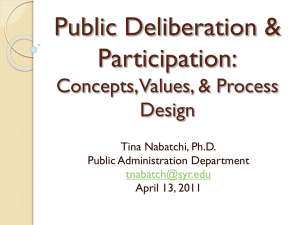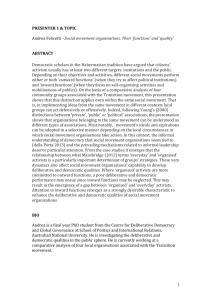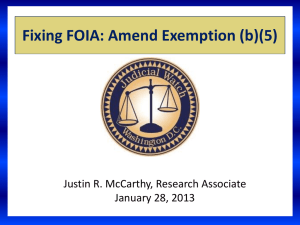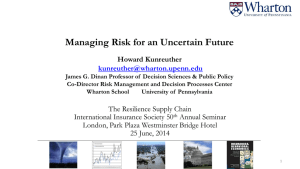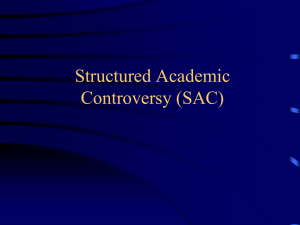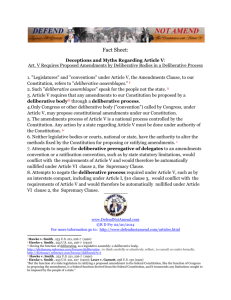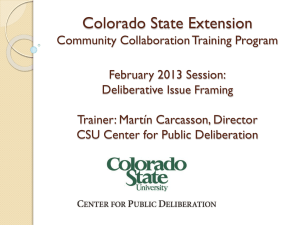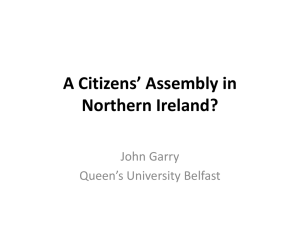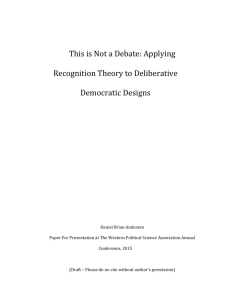Content Analysis and Legal Restatement: An Arena of Application
advertisement
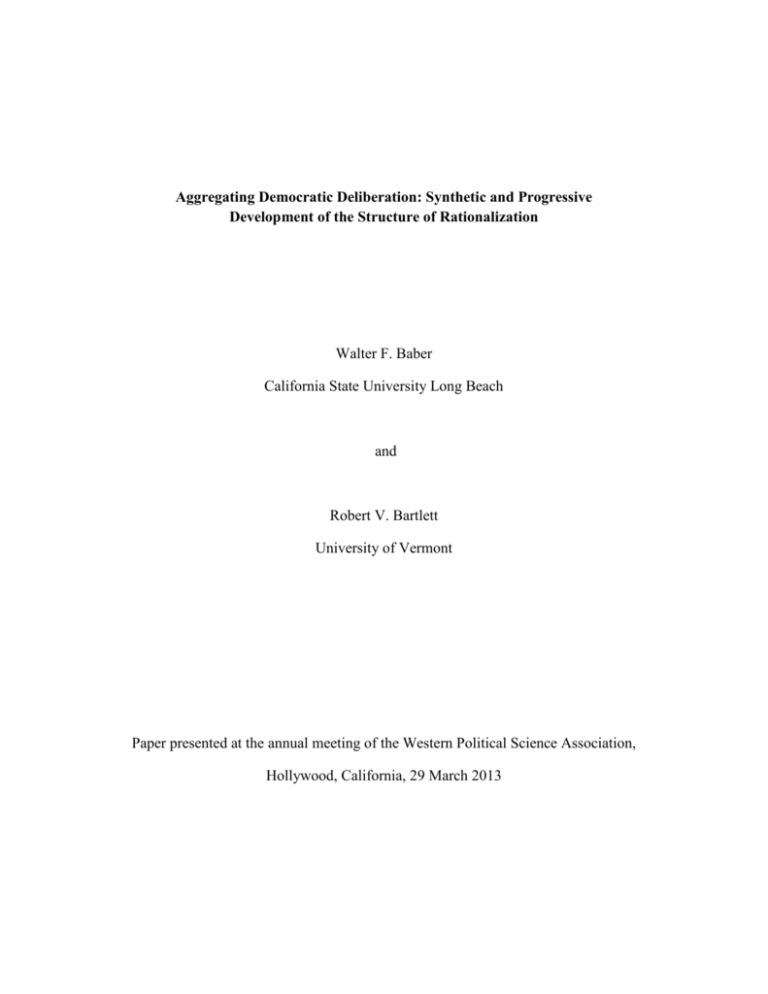
Aggregating Democratic Deliberation: Synthetic and Progressive Development of the Structure of Rationalization Walter F. Baber California State University Long Beach and Robert V. Bartlett University of Vermont Paper presented at the annual meeting of the Western Political Science Association, Hollywood, California, 29 March 2013 Activists and scholars interested in what political theory can contribute to environmental governance debates and action worry about several conceptual and methodological problems that deliberative democratic theorists and experimenters currently confront. These include: 1. how do we define and relate the roles of those who deliberate environmental quandaries and those who convene such deliberations, 2. what part do (or should) substantive experts play in processes of environmental deliberation, 3. what do we mean when we call environmental arguments "rational" or "public," and 4. how do we conceive of the relationship between deliberation and decision? A different (but allied) discipline, law, has dealt with many of these conceptual and methodological problems in the ways it has conceived of the project of restatement. Like content analysis in political science, restatement begins with a range of theoretically relevant subjects--in this case, reasons that the law can recognize as permissible justifications for a specific kind of judicial outcome. But beyond documenting how frequently and in what ways concepts and ideas identified a priori by researchers occur in a given text or narrative (as in content analysis), the objective of restatement is synthetic and progressive. The idea is to craft a comprehensive and precise statement of the underlying legal rationale for a certain category of decisions and to explore the potential paths along which we might expect (or want) that structure of rationalization to develop. Here we analyze the practice of legal restatement and we assess the usefulness of its premises, principles, and rules for political science, for the theory and practice of deliberative democracy, and for environmental governance. Our objective is to show that restatement is a 1 potentially useful mechanism for aggregating the considered opinions of deliberating citizens in ways that allow us progressively to develop legal structures that can contribute to the rationalization of the human relationship to the environment. We begin with a detailed discussion of the similarities and contrasts between legal restatement and its distant relative, content analysis as it is practiced in the social sciences. We then apply that pair of analytical techniques to a concrete example of citizen participation--juristic deliberation. We then employ the insights from that process to craft responses to the four questions posed above, responses that should guide the further development of the deliberative technique we present here. Finally, we offer a brief argument in favor of social scientific approaches to the development of new structures of regulatory law. Content Analysis and Restatement: The Dynamic Duo? Content analysis, as it is practiced in the humanities and social sciences, is a method of analyzing the text of various forms of communication. It involves a summarizing, as well as qualitative and quantitative analysis of, messages. It relies on the classical values of scientific methodology--attention to objectivity, intersubjectivity, a priori design, reliability, validity, generalizability, replicability, and hypothesis testing (Neuendorf, 2002). The underlying assumption is that the words and phrases that occur most often and most prominently in any communication reflect the core concerns of the message being conveyed. Word frequencies in print material, time counts in radio and television, keyword-in-context routines, and synonym and homonym analysis are common quantitative techniques. Qualitatively, content analysis can involve any methodology by which the content of communication is categorized and classified. 2 But the focus of content analysis and its methodological characteristics in any given instance depends on the purpose of the researcher. Practitioners of content analysis generally pursue one of a number of research purposes. By focusing on the source of communication, the encoding process used, and why the communication under examination was initiated and structured in the way that it was, a researcher can draw inferences about the antecedent conditions and intentions of the communication. By attending to the channel of communication used, the substantive content of the communication, and the nature of the target audience, it is possible to describe and draw inferences about the fundamental characteristics of the communication in question. By examining the decoding process used by the target audience, it is possible to draw conclusions about the consequences of communication (Holsti, 1969). Regardless of the particular focus of the research, certain common methodological concerns arise. Content analytic research can be categorized as employing either prescriptive or open methods of analysis. Prescriptive analysis uses a closely defined set of communication parameters and categories designed a priori by the researcher. Open analysis, on the other hand, employs more qualitative (some would say, impressionistic) techniques to tease the dominant messages, subject matter, and appropriate analytical categories from the text itself (McKeone, 1995). Each approach gives rise to particular problems. To the extent that a research design is prescriptive, it confronts an obvious challenge of validity--does it understand an instance of communication in a way that does justice to the intentions and understandings of the parties to that communication? If an open analysis design is used, questions of reliability arise--are data being coded in ways that are consistent, both within and across coders’ work (Krippendorff, 2004)? In either case, it is reasonable to wonder whether an analyst has been sufficiently 3 attentive to the potential difference between a communication’s manifest meaning (its actual wording) and its latent meaning (what the communicator intended) or its imbedded meaning (conscious or unconscious meaning embedded in a whole discourse). A feature of content analysis that offers a basis for optimism regarding its usefulness to advocates of democracy is the phenomenon of mimetic convergence. A feature of the long-term articulation of partisan competitions is that discursive articulations of multiple parties, through frequent repetition, combine to frame issues in ways that represent more than a mere conflict over the representation of interests. This recursive process of re-composition and re-articulation builds a shared construction of the choices and controversies confronting the polity. Over time, political actors re-orient their arguments and thematic selections to this constructed political reality in search of political advantage (Lipset & Rokkan, 1967). A content analytic examination of this process--identifying the sources of these constructs, revealing the intentions of their authors, and describing the consequences of their acceptance--offers the opportunity for citizen empowerment to replace elite manipulation. Restatement of the law is a method of legal analysis used, most prominently, by the American Law Institute (ALI). Its series of legal Restatements are sets of treatises intended to inform judges and lawyers about the general principles of the common law as it is found in the United States. Each Restatement volume is a summary and codification of the case law in a given area (torts, contracts, property, etc.). Although Restatements are not themselves binding law, they are widely recognized as highly persuasive legal authority because they are developed by legal specialists (professors, judges, and practicing attorneys) with special expertise in the area of law concerned. They are intended to represent the consensus of the American legal community as to what the law is and, to some extent, what it should become. This combination 4 of the descriptive and prescriptive strikes some as problematic, but it is conceptually consistent within the context of a legal system governed by the doctrine of stare decisis--the principle that judges ought to respect the precedent established by prior decisions and attend to the precedent that their own decisions establish. This principle clearly implies that existing legal doctrine establishes a presumptively legitimate pattern for its further development and application, though that conclusion is far from incontestable. Each topical section of a Restatement contains a principle of so-called Black Letter law, a section of Comments and Illustrations, and Reporters’ Notes providing a detailed discussion of all the cases that went into the legal principle summarized in that section. The intention is to provide not only a legal rule, but also the considerations that support the rule and the concrete circumstances that give rise to those considerations. In this way, the Restatement reduces the existing case law to a problem-specific general rule and it provides guidance regarding the application of that rule and its probable limits. This kind of information allows practicing attorneys to anticipate the reaction that judges will have to the arguments they can potentially advance on behalf of their clients. And it allows judges to decide cases consistent with authoritatively summarized precedent or, in cases of first impression, with an informed judgment about the direction that the law is developing. Criticisms of the Restatement movement in general as well as of particular Restatement volumes are legion (Adams, 2007). It is neither practical nor desirable to survey that entire discourse here, but we do call out certain elements of that criticism for the perspective offered regarding the methodological approach used by the ALI in its Restatement projects. At the outset, restatement largely avoids the reliability critiques leveled at content analysis. Restatements are a committee product, with drafts of each section being subjected to 5 exhaustive review and criticism by teams of specialists led by uniformly distinguished Reporters. Validity, however, is another matter. On that score, the Restatements have been criticized for going beyond merely reporting what the law is and asserting what the law (in the opinion of the ALI) believes the law should be. This may be a greater threat to the validity of conclusions based upon the Restatements now than it has been in the past because it is more common in second editions than in the first. Over time, the Restatements have become both more normative and more susceptible to overt interest group influence (Adams, 2004). Normativity is not entirely undesirable, especially in as much as progressive development of the law has always been an objective of the Restatement movement. Given that fact, the eventual attention of organized interests was inevitable. The solution to both potential problems is, of course, transparency. Moreover, one must also consider the argument that it is no more inappropriate for the ALI to consider how to accommodate the past to the present and the future than it is for common law courts to do the same thing (Wechsler, 1969). The prevalence of judicial elections and the level of attention given them by voters where they do occur provide little support for an argument that progressive development of the law by individual judges in chambers is more legitimate the same process carried by groups of professional specialists (including judges) operating in public. A more common criticism of the Restatements is that they are inherently conservative. The dominant variant of this theme is that the Restatement movement was a rearguard action against the advent of Legal Realism. This view is lent credence by the fact that both legal realists and the movement’s advocates were heard advancing it at the time that the ALI launched the Restatement project. Moreover, the Institute seems to have tacitly admitted the validity of this criticism by declaring its intention to make the second series of Restatements as dynamic as 6 the common law they purport to represent (Adams, 2007). In fact, one might offer this pattern of call and response as evidence that the ALI has achieved a level of pragmatic progressive reform (Hull, 1990) that could not have been reached either by common law courts resolving specific disputes or by legislators whose policy pronouncements arise from the competition of special interests rather than the issues presented by concrete cases. Finally, Restatement is but one element in a broader process that ultimately leads to the development of contending components of model statutes and eventual codification through legislative action (Posner, 1999, esp. 303309). Viewed in this light, Restatement is less a threat to democratic legitimacy than it is a stem on democratic government’s least dangerous branch (Bickel, 1986). Content Analysis and Legal Restatement: An Arena of Application So both content analysis and legal restatement have a potential role to play in the development of democratic norms. But the question remains--to what should we apply these analytical tools? Content analysis is commonly applied to the stuff of mass communications. In the political realm, this often means the rhetoric of parties and political campaigns. Legal restatements, on the other hand, are analytical summaries of legal opinions issued by judges in specific proceedings. Both political campaigns and legal decisions have clear, if often indirect, implications for the formation of democratic norms. Political rhetoric is often distorted by strategic (as opposed to normative) considerations that make it hazardous to draw direct conclusions about the meaning of assertions or their support within the polity. A legal opinion, on the other hand, is relatively unambiguous--at least on its face. A winner is declared and a 7 reason for the victory is given. The complexity arises from our attempts to draw inferences about how the case at hand will (or should) affect the outcomes of cases in the future. The formation of democratic will, as a multi-staged process, is related to both of these phenomena. It involves assertions that come from particular sources and are encoded in particular ways. Those assertions have specific characteristics. They are designed to channel selected content to target audiences. Moreover, those assertions are decoded in specific ways that affect how the messages are understood and acted upon. Content analysis is well suited to understanding these features of democratic will formation. What it can do less well is interpret the practices involved in resolving concrete disputes. The fact that one party to a contest prevails, often to only some extent with respect to only some aspects of the dispute, is evidence that one assertion (or cluster of assertions) has prevailed over another in some important way. What that assertion originally meant, and the reasons that it was structured in the way that it was, are no longer as important as is an analysis of the institutional response it prompted, how that response can be explained and justified, and what that response means for subsequent assertions about similar disputes. From the perspective of the political theorist, the problem is how a procedure can be constructed that elicits institutional responses to political assertions that are of normative interest. In research the results of which we have discussed elsewhere, we have developed hypothetical deliberative exercises in the formation of regulatory norms that are intended to transcend both national interest and cultural specificity (Baber & Bartlett, 2009). We have argued that for public policies to be fully rational they have to be both sustainable in substantive terms and fully democratic. Furthermore, we argued that to be fully democratic a public policy has to be both the product of democratic procedures and an embodiment of broadly shared normative 8 commitments Baber & Bartlett, 2005). This last standard is difficult to meet and harder still to measure rigorously. The problem of investigating normative attitudes regarding different forms of regulation is not unlike the challenge facing experimental economists who conduct research on citizen attitudes about alternate approaches to income redistribution. Our current research adapts some of the techniques developed in the existing research on distributive justice to assess alternative approaches to the normative issues posed by contending regimes of environmental protection (Baber, Bartlett, & Dennis, 2012). The point of departure for this project is research conducted by Norman Frohlich and Joe Oppenheimer (1992). Their empirical research in ethical theory involved a series of negotiations among small groups of individuals (normally five persons) who were asked to choose among four possible schemes of income distribution to be applied in a simulated economy. Their choice was then implemented in a series of simulations in which participants were asked to perform work for which they were paid and then their incomes were adjusted according to the policy they had previously adopted. Our research differs from that of Frohlich and Oppenheimer in several respects. Because participants are asked to choose among several regulatory norms rather than among redistributive policies, a more complex hypothetical situation is needed. Rather than a simple distribution of income, it is necessary to present participants with a more richly detailed set of circumstances involving an environmental hazard caused by one actor and imposed upon a different actor. In effect, we developed hypothetical legal cases, complete with parties to be heard, pleadings to be weighed, and philosophical problems to be resolved. This approach was first suggested to us by the work of Kenneth Culp Davis, the leading American theorist of administrative law (Davis, 1969). The factual circumstances of the cases we developed require participants to choose 9 between hypothetical outcomes that represent some of the underlying normative principles of global environmental protection--common but differentiated responsibility, normative precommitment, and distributional equity, to name a few. Moreover, because it is more difficult to “simulate” regulatory actions than instances of income and taxation, it was necessary to create a survey instrument to capture the experiences of participants and relate them to deliberative outcomes. Instead of focusing on the reactions that participants have when they experience the consequences of their policy choices, our research concentrates on the deliberative process that produces those choices and the participants’ level of normative commitment to the principles eventually chosen. A “pre-test” gathers demographic and socio-economic information from each participant as well as information regarding their existing attitudes toward environmental protection. A “post-test” revisits the attitudinal questions to measure changes in normative commitments. It also gathers information regarding participants’ reaction to the process of deliberation in which they have engaged and their level of commitment to the outcomes achieved. With some of these experiments as our raw data, it is possible to describe with greater clarity the roles that content analysis and legal restatement can play in research on democratic will formation. The assertions underlying the positions of each hypothetical litigant are developed from actual arguments advanced in support of contending regulatory regimes. To put each regime to a fair test of its democratic legitimacy requires that the arguments presented to our deliberators accurately represent the positions of the actual advocates of those regimes. Reproduction of those assertions must do justice to the intentions, content, targeting, and expectations of those who are the real-world advocates of the positions of our hypothetical litigants. Legal restatement, on the other hand, provides the means for summarizing the results 10 of these deliberations, characterizing the justifications given for those results, and suggesting how a set of general rules might be structured that would replicate those outcomes if it were applied to actually occurring regulatory problems. The challenges to any scholar wishing to pursue this kind of research are myriad. Chief among these is, obviously, that of representativeness. If the participant pool is insufficiently diverse, the results of the experiment will be open to insurmountable problems of reliability. Moreover, many of the deliberative dysfunctions that have been identified (i.e., groupthink) are particular dangers in deliberative groups that are insufficiently heterogeneous. Even when the problem of representation has been adequately addressed, however, there remain questions of a conceptual and methodological sort--those questions posed at the beginning of this essay. How do we define and relate the roles of those who deliberate environmental quandaries and those who convene such deliberations? What part do (or should) substantive experts play in processes of environmental deliberation? What do we mean when we call environmental arguments "rational" or "public?" How do we conceive of the relationship between deliberation and decision? These are questions about how one aggregates deliberatively informed opinion in ways that preserve their democratic provenance and enhance the legitimacy of the regulatory regimes founded upon them. Having provided a critical appraisal of both content analysis and restatement as techniques for aggregating and interpreting the views of participants in democratic deliberation, these are questions to which we now prepared to turn. Problems of Aggregation: Juristic Deliberative Solutions 11 All deliberative democratic theorists are confronted with the problem of how to define and relate the roles of those who deliberate problems of public policy and those who convene such deliberations. The technique we have developed, asking participants to deliberate hypothetical legal disputes, suggests a particular answer to this question. Participants in our exercises (which we have called “juristic deliberation”) are most similar to the members of a trial jury. Panel members are presented with detailed set of facts about a concrete but wholly hypothetical situation. Each of the fictional “parties” to the dispute has petitioned for its preferred outcome and provided arguments in support of its position. Members of the deliberative panel are then asked to choose between the positions of the parties, or to craft a resolution of their own, and to provide a statement of the reasons for their decision. In this research design, the role of the deliberative participants is to declare a winner in a discursive contest that has been presented to them in the form of a trial. This is a task that research on juries suggests that people of average backgrounds perform quite well. Assuming a reasonable level of attitudinal diversity, juries do not fall prey to the deliberative dysfunctions commonly cited in the literature. Moreover, juries tend to produce decisions that closely parallel those of trained jurists who have heard the same evidence--even where the case at hand is complex or technical in character (Vidmar & Hans, 2007). The role of the convener of a juristic deliberation, like that of the trial judge, is to supervise a process through which the facts and arguments of the “case” are presented to the jury. In adversarial systems, like that of the United States, this generally amounts to playing the role of umpire in the contest between attorneys who elicit facts from witnesses and present the arguments of their parties. In our research, however, the framer of the scenarios and petitions serves as an interpreter to the jury of both the facts and the arguments of the parties. The framer 12 does this by constructing a set of “facts” that capture the salient features of a real-world regulatory dilemma. He or she also builds the arguments of the parties to the hypothetical dispute from the political assertions of interests and individuals who advocate alternative approaches to regulating the problematic circumstances at hand. These functions are more nearly like the role of the judge in an inquisitorial system of litigation. Ultimately, someone, possibly the framer of a series of juristic deliberations, will also play a role similar to that of the ALI in crafting its Restatements. In thinking about the question of what part substantive experts might (or should) play in processes of environmental deliberation, two distinct roles immediately suggest themselves. First, the conveners of the deliberation play an obvious role as experts on the process of deliberation and decision itself. It can hardly be doubted that deliberative exercises can be structured in ways that distort the results. As an example, in our experimental design, participants are initially provided a form on which they are asked to render their decision and provide an explanation of it. The form does not suggest in any way that a vote should be taken or that a minority report is possible. If participants inform the convener that they are at a stalemate, a minority opinion form is at the ready and is provided. That form, however, is not provided in the initial materials given to the jury. The intention is to encourage the most serious effort to arrive at a consensus possible, both for the sake of empowering minority views and in order to promote a thorough airing of views. An alternate view, however, would be that the pressure for consensus might actually work to silence minority views and disempower those who hold them, although research on juries in actual trial courts does not provide much support for this concern (Vidmar & Hans, 2007. Nor do the responses to the post-deliberation questionnaire that we employ. Nevertheless, transparency in the research process and peer review of its results 13 are especially important in research of this sort. A generation of experience with content analysis in social scientific research suggests as much (Berelson, 1952; Krippendorf, 2004). Second, policy experts are a potential source of information that can be provided to participants in deliberative experiments in precisely the same way that expert witnesses provide guidance to trial juries. With respect to deliberations on regulatory matters, especially those involving environmental protection, this function is likely to be especially valuable. From a democratic perspective, however, the role of experts is likely to be especially troublesome. Again, however, both experience in the courtroom and systematic research on trial juries offer reassurance. Research indicates that, while jurors with higher levels of education more easily process expert testimony, even juries lacking such membership are able to differentiate between more and less reliable scientific evidence. Misunderstandings of such evidence appear more often to be the result of errors by lawyers and judges rather than the inadequacies of jurors (Lempert, 1993). Moreover, where expert witnesses are selected in the context of an adversarial process, jurors are able to adopt a critical attitude toward their evidence. Jurors do not uncritically accept expert testimony in those circumstances. Rather, they appear to employ common sense techniques to evaluate evidence for its clarity and informational value (Ivkovic & Hans, 2003). Finally, multiple studies have concluded that there is little evidence of any “white coat” syndrome. Jurors are generally make expert-specific decisions about whom to believe based on a sensible set of considerations--including “the expert’s qualifications, reasoning, factual familiarity, and impartiality” (Vidmar & Hans, 2007, 179). The implications of this research are clear. It may be both practical and economical for framers to distill the collective wisdom of substantive experts into a set of undisputed facts (as 14 we have done in our experiments), but there is no necessity to do so. If circumstances and finances allow, participants in deliberative decision making can be provided direct expert evidence. Expert testimony can be offered in an adversarial manner by representatives of civil society organizations standing on opposing sides of a regulatory problem. In the alternate, a single expert witness (selected by the convener) can be tasked to provide deliberators with a summary of the received wisdom in his or her field of expertise as it relates to the regulatory problem at hand. In this context, the expert would function in the manner of a “special master” such as those sometimes appointed by Federal judges under authority of Rule 53 of the Federal Rules of Civil Procedure to assist them in cases that are especially dependent on technical or scientific detail (Baber & Bartlett, 2005, 149-152). The appropriate discretion and impartiality of a convener in choosing among these alternatives can best be assured, as in other matters, by transparency and careful peer review of the results. Almost inevitably, questions of method lead to matters of substance. In this instance, discussion of the roles of framers, conveners, and expert testimony suggests a question about the character of the deliberative results we hope to produce. The first of these is, what do we mean when we say that an environmental (or other regulatory) decision is "rational" or "public”? No two terms have been dearer to the hearts of deliberative democratic theorists. Yet it is difficult to invoke these two ideas in the same breath without causing some wag to suggest that no “public” is capable of “rationality” in the first place. Much as democrats would like to deny it, there is substantial real-world experience (as well as considerable scholarship) underlying this derisive sort of humor. Finding public grounds for rational decision will, therefore, require us to focus our use of these terms. We can begin to do so by exploring the sociological concept rationality as it pertains to the rationalization of society. 15 Few serious students of the development of human society would dispute the proposition that rationalization of traditional life ways is a central element of modernity and an indispensable precondition for the development of democratic forms of governance. There is, on the other hand, considerable variation in the attitudes that various scholars have adopted toward the process. For his part, Max Weber approaches the question with the detachment that is the hallmark of his work. Denying that rationalization represents anything like the triumph of “reason” over “intuition,” Weber characterizes rationalization as something external to the values and intentions of the person. The advent of rationalism is “not inherent in the creator of ideas or of 'works,' or in his inner experience; rather, the difference is rooted in the manner in which the ruled and led experience and externalize these ideas.” The rationalization of society “proceeds in such a fashion that the broad masses of the led merely accept or adapt themselves to the external, technical resultants which are of practical significance for their interests . . . whereas the substance of the creator’s ideas remain irrelevant to them” (Weber, 1978, 1116-7). Rationality is nothing more than a wave of technical improvement in social organization that sweeps over humanity without fundamentally disturbing its normative orientation – in Weber’s terminology, its “value-rationality” (24-26, 339). In the hands of Jurgen Habermas, however, the rationalization of society takes on a more ominous character. Habermas (1987) sees the institutionalization of the instrumental rationality of bureaucracies and market-forces proceeding in much the same way as does Weber. But, he attaches a far different normative significance to it. Habermas contrasts technical rationality with the practical rationality that governs what he calls communicative action. Communicative action is concerned with ideas of social importance that are mediated through processes of communication in natural languages. By contrast, technical rationality governs systems of 16 instrumentality--primarily systems of capital accumulation and bureaucratic power that are concerned with ideas of instrumental importance only within those systems. For Habermas, then, the contrast between technical and practical rationality are matters of both form and substance. These modes of rationality do not coexist peacefully, each in its own domain. The “imperatives” of autonomous subsystems of modern society (capital and bureaucracy) make their way into the “lifeworld” of communicative action. They invade traditional life “from the outside – like colonial masters coming into a tribal society – and force a process of assimilation on it.” The result is a “fragmented consciousness” that blocks personally and socially valuable insights and the development of collective wisdom “by the mechanism of reification” (355). This dispute over the normative significance of rationality is of more than passing interest for deliberative democrats because it bears directly on the justifications one can offer for governance – understood as a set of relationships in which the legitimate public use of coercive force is one possible outcome of deliberation (Larmore, 2008). Deliberative democrats have, generally speaking, responded to this problem by insisting decisions that are public in this sense require the support of reasons that are equally public. For John Rawls, this means that our collective arrangements must be supported by reasons not grounded in comprehensive doctrines (such as religions) but are of a character that all citizens could potentially accept them. “Since many doctrines are seen to be reasonable, those who insist, when fundamental political questions are at stake, on what they take as true but others do not, seem to others to insist on their own beliefs… They impose their own beliefs because, they say their beliefs are true and not because they are their beliefs. But this is a claim all equally could make; it is also a claim that cannot be made by anyone to citizens generally. So when we make such claims, others, who are themselves reasonable, must count us unreasonable” (Rawls, 1993, 61). 17 For Habermas, however, public reasons are somewhat different. Publicity, in his view, is not so much a characteristic of the reasons themselves as a quality of the reasoning that produces them. Habermas develops a “discourse ethics” from an empirically based understanding of the praxis and conditions of democratic discourse itself. In his view, democracy is predicated on an ideal speech situation in which “communication is impeded neither by external contingent forces nor, more importantly, by constraints arising from the structure of communication itself” (2001, 97). This situation produces a genuinely deliberative politics as a result of the dynamic interplay between “democratically institutionalized” practices of collective will formation” and a freeflowing process of “informal opinion-formation” in civil society (1996, 308). A useful way to characterize this distinctive viewpoint is that, whereas Rawls has adopted the observer perspective toward public reasons, Habermas predicates the public quality of political reasoning on the perspectives, values, and intentions of the participants in democratic deliberation themselves (McCarthy, 1994). Public reason is not an independent standard one aspires to meet. It is, rather, a consensus that deliberating citizens come to in a process of mutual reciprocity. When we employ these contending perspectives on rationality and publicity to evaluate juristic deliberation as it has already been described, a number of useful observations are possible. First, the deliberating citizens in a juristic democracy exercise are, by their very nature, impartial. Their own material interests are not involved in the dispute (which, after all, is hypothetical) and any philosophical or religious viewpoints they might hold are relevant only to the extent that they can be expressed in sufficiently public terms to gain the assent of their fellow jurists. Second, any narrowing of perspective that might result from the unavoidable limit to the deliberative diversity imposed by a “jury” structure is mitigated by both the transparency of the research and the influence of peer review imposed by the social scientific method. Third, the 18 danger of elite influence over the deliberative process can be substantially ameliorated by inclusion of a broad range of civil society perspectives, either in the pleadings of the hypothetical parties or by the use of amicus briefs solicited by the deliberation conveners. In this way, the richness and variety of informal opinion-formation (so valued by Habermas and avoided by Rawls) can be incorporated into democratic deliberation in a manageable form. Fourth, the close relationship between rationality and publicity is conceptual rather than coincidental. To see more clearly why this is the case, consider the example of rationality review in constitutional law. Courts have consistently interpreted both the due process and equal protection clauses of the United States Constitution to require that the government act rationally. By this is meant simply that public measures must be at least minimally related to the promotion of some public value--which is understood to be a value that advances the interests of all impartially (Suntein, 1993). The second substantive question raised by the deliberative methodology described here is, how do we conceive of the ultimate relationship between deliberation and decision? This question is well known among deliberative theorists as the problem of deliberative uptake. A useful structure for exploring this question, with respect to virtually any deliberative exercise, is provided by Robert Goodin and John Dryzek (2006), who identify eight different ways that deliberative mini-publics might affect the course of public decision making. First, a mini-public might actually make public policy. The limiting case of actually making policy occurs when a mini-public is formally empowered as part of a decision-making process. This arrangement is usually difficult to imagine, but somewhat less so with respect to juristic deliberation. One of the conceptual parents of the technique, Kenneth Culp Davis, originally proposed the adjudication of hypothetical cases by actual administrative courts when 19 the judge(s) could see the need for guidance to a regulated industry but could not analyze the issues at a level of generality sufficient to engage in rule-making (1969). An administrative court facing a similar need to promulgate regulatory policy, but also wishing to provide policy with democratic provenance, might well adopt the approach we have devised. More generally, administrative authorities who seek to formalize decentralized and informal regulatory arrangements that have grown up from local practice (Ostrom, 2008) might wish to assemble a series of mini-publics drawn from the communities whose practices the new policy is expected to subsume and have them deliberate a hypothetical (or series of hypotheticals) crafted to resolve the issues at hand. Second, the much more frequent case occurs when a mini-public provides recommendations in an existing political process. These recommendations are “taken up” with no formal guarantee that they will be taken any further by any macro-political institution. Legislative bodies or administrative courts with rule-making authority might wish to commission juristic deliberations of mini-publics in order to gain insight into the views of average citizens who have had the opportunity to examine the relative merits of competing policy prescriptions in some depth and in the context of a concrete (though hypothetical) dispute. This might be particularly useful to officials of international governmental organizations, who are unlikely to have an intimate knowledge of the wide range of political, social, and cultural groups that their decisions will affect. Third, organizations sponsoring citizen dialogues of one sort or another can have as one of their major goals simply to provide information. For example, non-governmental organizations often have a significant interest in the actions of government officials. Traditional lobbying techniques certainly have a place in the pursuit of those interests. But governmental 20 officials may be more likely to pay attention to the results of deliberative exercises by minipublics (even when they are sponsored by interested groups) than toward nakedly self-interested appeals of a more conventional sort. The relatively low cost of sponsoring mini-public deliberations offers organizations that represent the poor and historically under-represented populations an opportunity to level the political playing field to some extent. Fourth, mini-publics can shape public policy by market testing potential policy solutions. There are instances of commercial ventures benefiting in just this way from commissioned minipublics (Goodin and Dryzek, 2006). This possibility might be especially attractive to the professional staffs charged with the progressive development of international conventions. For instance, the ability to anticipate the reception of specific policy regimes could improve the feasibility of proposed protocols to the United Nations Framework Convention on Climate Change. Knowing that Americans were not as opposed to the concept of common but differentiated responsibility as their elected officials might have allowed for the development of a set of formal rules that applied to more of the nations of the world but was so cross-cut with specific exceptions that they nearly consumed the rules themselves. This would have allowed advocates of the Kyoto Protocols to “market” them as universal in a formal sense, even though they would have forced changes on only a relative handful of nations in practice. Fifth, mini-publics can help provide symbolic legitimation for public policies in whose process of production they have played a part. This much goes very nearly without saying, although this quality of mini-publics is a double edged sword from the democrat’s point of view. Like any other form of social scientific research, juristic deliberation is subject to manipulation by special interests. But for this form of mini-public to have much influence over policy processes it must, by definition, be public. The relative ease and economy with which competing 21 organizations can replicate juristic deliberative exercises makes this form of collective willformation inherently difficult to counterfeit without being contradicted in highly damaging ways. Sixth, mini-publics can provide confidence building or constituency building benefits by promoting “empowerment” in the psychological or sociological rather than the strictly political sense. Participants in our juristic exercises, like those in other deliberative mini-publics, routinely report very positive reactions to the process of deliberation itself. This result tracks closely the widely reported positive effect of service on actual trial juries (Vidmar & Hans, 2007), even where juries fail to reach verdicts. The inescapable conclusion is that the deliberative experience does not have to produce tangible results to have a positive impact on participants. Being taken seriously and being listened to by others is an inherently valuable experience. Seventh, participatory, consultative mechanisms also sometimes serve as a means of public oversight, forcing official accountability. Whenever the policy actions of public officials can be re-rendered as possible resolutions of concrete disputes, those policies can be subjected to the test of considered public opinion (as opposed to mass survey over-simplification) by the use of juristic deliberation. Eighth, mini-publics offer a possible solution to the problem of cooptation in public participation. The discursive component of mini-publics and their relatively unstructured makes their proceedings particularly hard to predict or control, and hence unsuited to elite co-option. In the case of juristic deliberation, the low cost and relative simplicity of the methodology allows for nearly infinite replication in nearly infinite variation. Social Science as a Source of Law 22 We have advanced a theory that unites content analysis and legal restatement in an analytical framework for the interpretation of discourses aimed at the resolution of concrete disputes with significant implications for public policy, especially environmental protection. That analytical framework can be applied in a specific form of policy research through the use of a particular type of mini-public--juristic deliberation. This deliberative technique can offer responses to several of the most persistent questions confront advocates of deliberative democracy. In this final section, we offer several observations regarding the use of social scientific research as a source for the progressive development of legal rules, specifically, rules regarding the protection of the global environment. Our comments pertain to the value of scientific methods, the importance of diverse and disinterested deliberators, and the value of a fully inclusive discursive process. Social scientists are, first and foremost, members of academic disciplines. For this reason, the incentive structures within which they live their professional lives differ markedly from those of government officials, either elected or appointed. For any of their efforts to bear fruit, social scientists must eventually submit their work to review by their peers. This process, even though it operates imperfectly, tends to advance certain values. One is transparency. It is difficult to get the results of one’s research published if it contains significant areas in which one’s procedures or results are obscure. Furthermore, empirical findings are of far greater value (both personally and to the discipline) if they are subject to replication. This further encourages transparency as well as simplicity of design and care in implementation. Ideally, these characteristics of social scientific research make its results reasonably reliable even if they are nearly always tentative to some extent. For this reason, public officials charged with the 23 development and implementation of regulatory regimes proceed at their peril if they ignore social scientific findings that cast doubt on the assumptions underlying their rule structures. Social scientists, whatever their professional merits, remain mere mortals. They are as susceptible as anyone to both conscious and unconscious forms of bias. The various features of scientific methods guard against this kind of bias to some considerable extent. Deliberative designs of the sort that we propose add another layer of protection. A diverse set of disinterested deliberators is likely to frustrate most efforts to build particular outcomes into an experimental design. It should be noted that most of the deliberative dysfunctions that have been noted in the literature arise from deliberations among individuals who are homogenous in ways that are relevant to the outcomes. Even if principal investigators fail to avoid this pitfall (for whatever reason), others seeking either to replicate or to challenge their results are likely to be their undoing. It is vitally important that deliberative research of the kind we have pursued offers opportunities for the widest possible variety of discourses to find expression. Even the most diverse juristic deliberation is unlikely to contain within its participant group the entire range of potentially meaningful discourses regarding the issue under consideration. The parties to a hypothetical dispute, therefore, serve as the conduit for the complexities of the real world to enter into the deliberation. In the hands of an unscrupulous or lazy investigator, it is certainly possible for these parties to become nothing more than a Greek chorus, chanting in a homogeneous way the framer’s own message as a mere commentary on the dramatic action of the jury. The careful and conscientious investigator will take great pains to represent all of the political themes and interests that bear on the policy problem of concern. The results will suffer at the hands of peers if not. 24 References Adams, Kristen D. (2007) Blaming the Mirror: The Restatements and the Common Law. Indiana Law Review, 40, 205-270. ______________ (2004) The Folly of Uniformity: Lessons from the Restatement Movement. Hofstra Law Review, 33, 423-472. Baber, Walter F. and Robert V. Bartlett (2005) Deliberative Environmental Politics: Democracy and Ecological Rationality. Cambridge, MA: MIT Press. (2009) Global Democracy and Sustainable Jurisprudence: Deliberative Environmental Law. Cambridge, MA: MIT Press. Baber, Walter F., Robert V. Bartlett, and Christopher Dennis (2012) Reforming Global Environmental Governance Through Deliberative Norm Building. Paper presented at the Lund Conference on Earth System Governance: Towards a Just and Legitimate Earth System Governance--Addressing Inequalities. Lund, Sweden, 19 April. Bickel, Alexander (1986) The Least Dangerous Branch: The Supreme Court at the Bar of Politics. New Haven, CT: Yale University Press. Berelson, Bernard (1952) Content Analysis in Communication Research. Glenncoe, IL: Free Press. Davis, Kenneth C. (1969) Discretionary Justice: A Preliminary Inquiry. Baton Rouge, LA: Louisiana State University Press. Frohlich, Norman and Joe Oppenheimer (1992) Choosing Justice: An Experimental Approach to Ethical Theory. Berkeley, CA: University of California. 25 Goodin, Robert and John Dryzek (2006) Deliberative Impacts: The Macro-Political Uptake of Mini-Publics. Politics and Society, 34, 219-244. Habermas, Jurgen (1987) The Theory of Communicative Action, Volume 2. Thomas McCarthy (trans.). Boston, MA: Beacon Press. _______________ (1996) Between Facts and Norms: Contributions to a Discourse Theory of Law and Democracy. Willian Rehg (trans.). Cambridge, MA: MIT Press. _______________ (2001) On the Pragmatics of Social Interaction: Preliminary Studies in the Theory of Social Interaction. Barbara Fultner (trans.). Cambridge, MA: MIT Press. Holsti, Ole R. (1969) Content Analysis for the Social Sciences and Humanities. Reading, MA: Addison-Wesley. Hull, N. E. H. (1990) Restatement and Reform: A New Perspective on the Origins of the American Law Institute. Law and History Review. 8, 55-92. Ivkovic, Sanja and Valerie Hans (2003) Jurors’ Evaluations of Expert Testimony: Judging the Messenger and the Message. Law and Social Inquiry. 28, 441-462. Krippendorf, Klaus (2004) Content Analysis: An Introduction to its Methodology. 2nd ed. Thousand Oaks, CA: Sage. Larmore, Charles (2008) The Autonomy of Morality. New York: Cambridge University Press. Lempert, Richard (1993) Civil Juries and Complex Cases: Taking Stock after Twelve Years. In Robert Litan (ed.) Verdict: Assessing the Civil Jury System. New York: Brookings Institute Press. 181-212. Lipset, Seymour and Stein Rokkan (1967) Party Systems and Voter Alignments: CrossNational Perspectives. New York: Free Press. 26 McCarthy, Thomas (1994) Kantian Constructivism and Reconstructivism: Rawls and Habermas in Dialogue. Ethics 105, 44-63. McKeone, Dermont (1995) Measuring your Media Profile: A General Introduction to Media Analysis and PR Evaluation for the Communications Industry. London: Gower Press. Neuendorf, Kimberly A. (2002) The Content Analysis Guidebook. Thousand Oaks, CA: Sage. Ostrom, Elinor (2008) Governing the Commons: The Evolution of Institutions for Collective Action. New York: Cambridge University Press. Posner, Richard A. (1999) The Problematics of Moral and Legal Theory. Cambridge, MA: Harvard/Belknap). Rawls, John (1993) Political Liberalism. New York: Columbia University Press. Sunstein, Cass (1993) The Partial Constitution. Cambridge, MA: Harvard University Press. Vidmar, Neil and Valerie Hans (2007) American Juries: The Verdict. Amherst, NY: Prometheus. Weber, Max (1978) Economy and Society: An Outline of Interpretive Sociology. Guenther Roth and Claus Wittich (eds.). Berkeley, CA: University of California. Wechsler, Herbert (1969) The Course of the Restatements. American Bar Association Journal, 55, 147-201. 27

